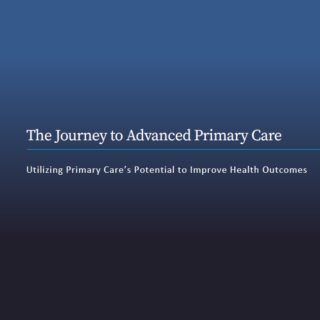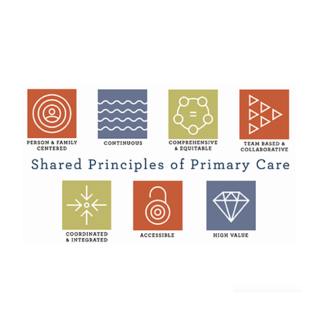Advanced Primary Care
Employers know that primary care is essential to a healthy workforce and employees’ access to a high-value health care system. Studies show that robust systems of primary care can lower overall health care utilization, disease and death rates and increase the use of preventive services.

That’s why PBGH has developed a set of advanced primary care attributes used by payers, providers and health care purchasers to incentivize high-quality, lower-cost primary care with patients at the center of every interaction. We are working to scale high-quality primary care through the development of a national network that is vetted to include a region’s highest performing primary and specialty care practices.
PBGH’s approach to advanced primary care redirects existing health care spend to high-quality, equitable and evidence-based care while holding total cost flat.
Click here to read how PBGH can bring advanced primary care to your employees and families and learn why employers , providers and payers trust PBGH Care Excellence to certify advanced primary care.
Initiatives
A History of Pioneering Advanced Primary Care
Read More about A History of Pioneering Advanced Primary CarePBGH has been a pioneer in defining and promoting the adoption of advanced primary care.
PBGH Care Excellence Program
Read More about PBGH Care Excellence ProgramThe PBGH System of Excellence for advanced primary care with precision specialty referrals offers employers a way to supplement existing health plan offerings.
California Advanced Primary Care Initiative
Read More about California Advanced Primary Care InitiativeThe California Advanced Primary Care Initiative is an effort to strengthen the primary care delivery system throughout the state.
Advanced Primary Care Resources
Read More about Advanced Primary Care ResourcesThrough successive initiatives and in collaboration with a diverse group of committed stakeholders, PBGH has spearheaded efforts to create a blueprint for optimized primary care.
PBGH Health Value Index
Read More about PBGH Health Value IndexA first-of-its-kind tool backed by the purchasing power of more than two dozen large employers.
Payment Reform and Quality Improvement
Read More about Payment Reform and Quality ImprovementPBGH works with policymakers to advance the development and application of alternative payment models that hold providers accountable for quality of care.
Primary Care Payment Reform Workgroup
Read More about Primary Care Payment Reform WorkgroupThe PBGH National Primary Care Payment Reform work group, comprised of large employers and convenes purchasers and other stakeholders to build consensus for new payment models that support and enable advanced primary care.
Behavioral Health Integration
Read More about Behavioral Health IntegrationPBGH is supporting the development of tools and systems that can enhance the continuity and coordination of physical and mental health in the primary care setting.
Featured

Strengthening Health Equity through Primary Care Transformation
Strategic investments in primary care, as demonstrated by the California Advanced Primary Care Initiative, enhance health care equity and quality through collaborative efforts among health plans, providers and purchasers.

Advanced Primary Care Key to Reducing Health Inequities
Robust, comprehensive primary care – a critical foundation for a more cost-effective, high-functioning health system – is equally important in helping boost health equity.

8 Steps to Implementing Advanced Primary Care
Despite these outsized benefits, misaligned financial incentives, chronic under-investment, infrastructure barriers and a lack of integration with other elements of care continue to severely constrain primary care’s impact on the health of American workers and families.

Strengthening Primary Care: A Pilot with Four Large Purchasers
Together with the Integrated Healthcare Association (IHA), PBGH brought together four large health care purchasers in California to pilot this set of performance measures that emphasize patient experience and outcomes.

Employers Are Driving Innovations in Primary Care
Large employers are increasingly working with existing direct contracting partners and new vendors to enhance primary care, which includes, among other things, the integration of behavioral health care.

A Little Less Conversation, A Little More Action
Large employers and health care purchasers have increasingly begun to take actionable steps to strengthen primary care, the critical precursor to a high-quality, cost-effective health care system.

Using Primary Care’s Potential to Improve Health Outcomes
Through successive initiatives and in collaboration with a diverse group of committed stakeholders, PBGH has spearheaded efforts to create a blueprint for “advanced primary care.”

Quality Improvement Project to Modernize Primary Care Launched
Covered California, the California Public Employees’ Retirement System (CalPERS) and the Purchaser Business Group on Health (PBGH) are partnering to launch a pilot program to promote improvement in primary care which will benefit all Californians.
Resources

PBGH Care Excellence Program
High quality primary care is one of the most underused strategies for controlling health care costs and improving employee health. Unfortunately, employers cannot identify the providers who meet their employees’ needs.
Until now. The PBGH Care Excellence Program is the only accreditation that uses PBGH’s employer-defined standards.

PBGH Direct Contracting Forum: Key Takeaways for Employers

PBGH Comment on CMS Medicare Physician Fee Schedule Proposed Rule for CY 2025

RFI Response to Senators Whitehouse and Casey

Better Employee Health, Increased Productivity and Lower Costs

Advanced Primary Care Request for Information 1.0

The Journey to Advanced Primary Care

Advanced Primary Care Measurement Pilot

Advanced Primary Care Measure Set

PCC Shared Principles of Primary Care

Advanced Primary Care: Defining a Shared Standard

Advanced Primary Care: Defining a Shared Standard Technical Brief
Announcements
PBGH Launches its Advanced Primary Care-Driven Health Care Network in Puget Sound, Washington
Boeing, eBay and Other Large Employers Now Offering Advanced Primary Care and High-Value Specialist Referrals to Employees and Families Purchaser […]
Quality Improvement Project to Modernize Primary Care Launched
Covered California, the California Public Employees’ Retirement System (CalPERS) and the Purchaser Business Group on Health (PBGH) are partnering to launch a pilot program to promote improvement in primary care which will benefit all Californians.
Past Events and Training

California Association of Health Plans Annual Conference
Crystal Eubanks, Executive Director at the California Quality Collaborative and Vice President of Care Transformation at the Purchaser Business Group on Health, will present on the California Advanced Primary Care Initiative’s work to improve primary care delivery.

PBGH System of Excellence Pre-Launch – San Antonio
Join PBGH and our employer members in San Antonio, Texas on July 31, 2024, for the pre-launch of PBGH’s groundbreaking System of Excellence coming to Texas in 2025.

CQC Webinar – Advanced Primary Care: Piloting Practice Level Measurement
A webinar describing the next step in California’s journey to scale high quality, efficient and patient-centered primary care, also known as Advanced Primary Care (APC).

CQC Webinar: Increase Depression Screening
In this meeting, attendees shared challenges and questions related to depression screening at their organizations, and identified a next step they could apply at their own organizations.